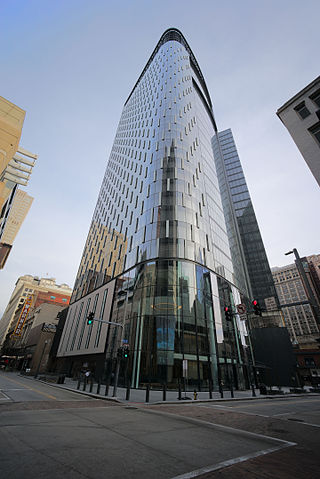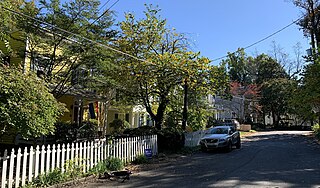
Georgetown is a historic neighborhood and commercial district in Northwest Washington, D.C., situated along the Potomac River. Founded in 1751 as part of the colonial-era Province of Maryland, Georgetown predated the establishment of Washington, D.C. by 40 years. Georgetown was an independent municipality until 1871 when the United States Congress created a new consolidated government for the entire District of Columbia. A separate act, passed in 1895, repealed Georgetown's remaining local ordinances and renamed Georgetown's streets to conform with those in Washington, D.C.

Riggs Bank was a bank headquartered in Washington, D.C. For most of its history, it was the largest bank headquartered in that city. On May 13, 2005, after the exposure of several money laundering scandals, the bank was acquired by PNC Financial Services.

Downtown Pittsburgh, colloquially referred to as the Golden Triangle, and officially the Central Business District, is the urban downtown center of Pittsburgh, Pennsylvania, United States. It is located at the confluence of the Allegheny River and the Monongahela River whose joining forms the Ohio River. The triangle is bounded by the two rivers.

William Wilson Corcoran was an American banker, philanthropist, and art collector. He founded the Corcoran Gallery of Art.

The PNC Financial Services Group, Inc. is an American bank holding company and financial services corporation based in Pittsburgh, Pennsylvania. Its banking subsidiary, PNC Bank, operates in 27 states and the District of Columbia, with 2,629 branches and 9,523 ATMs. PNC Bank is on the list of largest banks in the United States by assets and is one of the largest banks by number of branches, deposits, and number of ATMs.

Healy Hall is a National Historic Landmark and the flagship building of the main campus of Georgetown University in Washington, D.C., United States. Constructed between 1877 and 1879, the hall was designed by Paul J. Pelz and John L. Smithmeyer, both of whom also designed the Thomas Jefferson Building of the Library of Congress. The structure is named after Patrick Francis Healy, who was the President of Georgetown University at the time.

Waddy Butler Wood was an American architect of the early 20th century and resident of Washington, D.C. Although Wood designed and remodeled numerous private residences, his reputation rested primarily on his larger commissions, such as banks, commercial offices, and government buildings. His most notable works include the Woodrow Wilson House and the Main Interior Building.

Streetcars and interurbans operated in the Maryland suburbs of Washington, D.C., between 1890 and 1962.
James E. Rohr is former chairman of PNC Financial Services Group and former CEO. Rohr served as CEO from May 2000 to April 2013 and as chairman from May 2001 to April 2014, both times taking over for Tom O'Brien. He was the chairman of the Carnegie Mellon University Board of Trustees until the start of the 2021 Academic year.

The Hyatt Regency Indianapolis is part of PNC Center, a mixed-use high-rise complex in Indianapolis, Indiana. The complex rises 22 floors and 268 feet (82 m) in height, and is currently the 17th-tallest building in the city.

Riggs National Bank is the historic former headquarters building of Riggs Bank, located at 1503–1505 Pennsylvania Avenue, Northwest, Washington, D.C., in the downtown Washington, D.C. neighborhood.

The Grant Road Historic District is located in the Tenleytown neighborhood of Washington, D.C. The two-block historic district is what remains of a former settlement in rural Washington County in the District of Columbia. It includes 13 contributing buildings and the road itself, a narrow remnant of a country road that was used by soldiers in the Civil War. Following the war, the road was named after Civil War general and President Ulysses S. Grant. Grant Road developed into a residential street lined with mostly small, two-story homes for working-class people.

The Financial Historic District, previously known as the Fifteenth Street Financial Historic District, is a historic district in Washington, D.C. The boundaries of the historic district include 38 buildings, 2 of which are non-contributing properties. Before 2016, the historic district included 20 buildings. The construction of the Treasury Building just east of the White House played a significant role in the financial district's development. Major banks and other financial institutions wanted to be close to the Treasury Building; therefore, many of the historic district's buildings were constructed along 15th Street NW, from Pennsylvania Avenue to I Street.
The Bank of Washington, later named The National Bank of Washington and abbreviated as NBW, was the first bank established in Washington, D.C. After suffering from bank failure in 1990, the bank was acquired by Riggs Bank.

Stewart's Castle, also referred to as Castle Stewart or Stewart's Folly, was a mansion in Washington, D.C., located on the north side of Dupont Circle between Connecticut Avenue and Massachusetts Avenue. The house owed its various names to the original owner, Senator William Morris Stewart, the imposing, turreted facade, and its prominence in an area considered undesirable at the time of its construction. Designed by architect Adolf Cluss, the house was completed in 1873 but only stood for 28 years. It was badly damaged in a fire in 1879 but later repaired and rented to the Chinese Legation from 1886 to 1893. The house was sold to Senator William A. Clark, who razed it in 1901, intending to build a new residence. The plans never came to fruition. The site remained vacant for over 20 years until the construction of a commercial building, which still stands.

The Georgetown Car Barn, historically known as the Capital Traction Company Union Station, is a building in the Georgetown neighborhood of Washington, D.C., in the United States. Designed by the architect Waddy Butler Wood, it was built between 1895 and 1897 by the Capital Traction Company as a union terminal for several Washington and Virginia streetcar lines. The adjacent Exorcist steps, later named after their appearance in William Friedkin's 1973 horror film The Exorcist, were built during the initial construction to connect M Street with Prospect Street.

Robert O. Scholz (1895–1978) was an American architect from Washington, D.C., who is considered one of the city's most important Art Deco designers. A native of New York City, his German parents later moved to Chicago, where he studied at the Armour Institute. Scholz briefly served during World War I before moving to Washington, D.C. He worked as an engineer and draftsman before starting his own architectural firm in 1922.

The Freedman's Bank Building, previously known as the Treasury Annex, is a historic office building located on the corner of Madison Place and Pennsylvania Avenue NW in Washington, D.C. It sits on the east side of Lafayette Square, a public park on the north side of the White House, and across from the Treasury Building. The adjoining properties include the Howard T. Markey National Courts Building to the north and the former Riggs National Bank to the east.

People of Irish descent form a distinct ethnic group in Washington, D.C., and have had a presence in the region since the pre-American Revolution period.

















